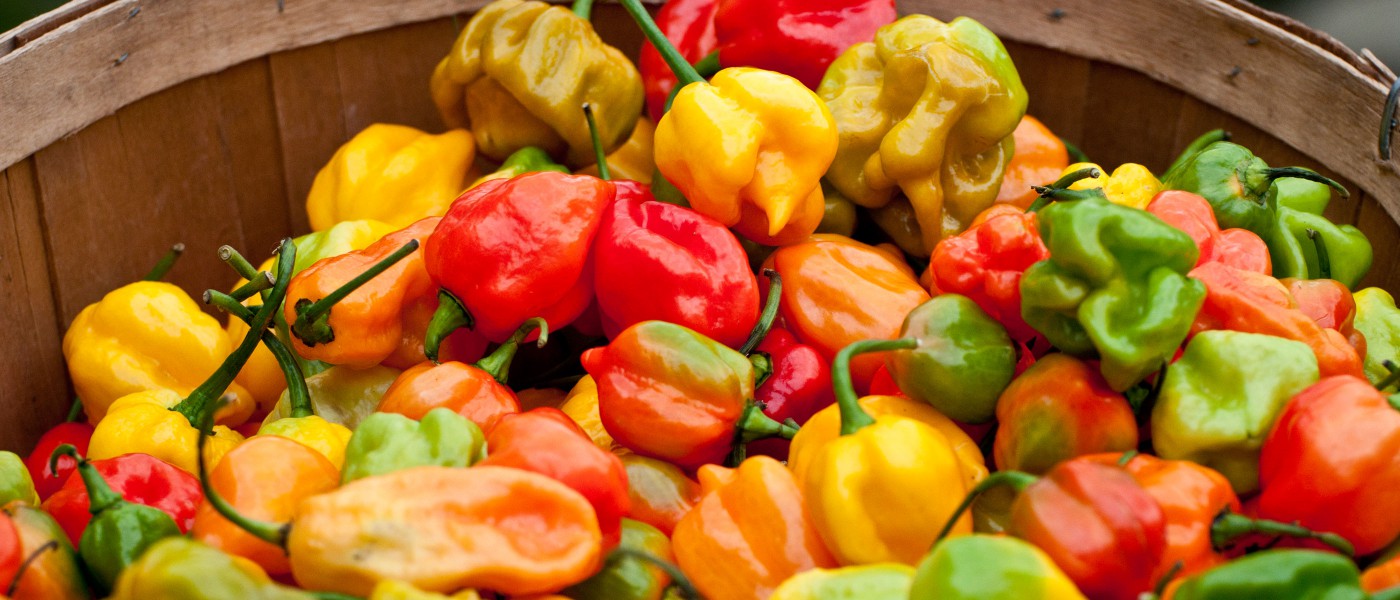Peppers from the Herb Garden
From hot to mild and in an array of colors, the peppers are popping in the Herb Garden this week. Curator Caleb Leech keeps a close eye on all the fruits, veggies, and herbs in the Garden and harvests them once they're ready. I was lucky enough to stop by at the right time to get a sample and a lesson on each of the peppers he was picking. Not only do chiles have distinct colors, textures, and aromas, but the flavors (and heat) are incredibly varied.
Below is a selection of some of the peppers I was able to try along with some information on each of them. Stop by and take a look for yourself in the Herb Garden, or come to BBG's Chile Pepper Festival!
‘Ampuis’ Pepper
Capsicum annuum ‘Ampuis’
This rare French cultivar (pronounced om-Poo-ee) has stubby, lanternlike fruits that ripen to red. The flesh is crispy and has a sweet flavor with slight hints of heat. The fruits are popular for frying.
Bell Pepper
Capsicum annuum Bell Group
These sweet peppers are plump and bell-shaped, featuring either three or four lobes. Inside the thick flesh is an inner cavity with edible bitter seeds and a white spongy core. Bell peppers contain a recessive gene that eliminates capsaicin, the compound responsible for the hotness of chiles.
‘Black Scorpion Tongue’ Chile
Capsicum chinense ‘Black Scorpion Tongue’
This rare and very hot pepper has wrinkled, tongue-shaped fruits that ripen from purple to cream and finally to red. Along with its hot flavor, ‘Scorpion Tongue’ is unique in shape and makes an attractive ornamental.
‘Caribbean Red’ Habanero Pepper
Capsicum chinense (Habanero Group) ‘Caribbean Red’
Often cited as the hottest chile in the world, with a Scoville rating of 400,000, the red habanero turns from a light green to deep glossy red as it matures. It has a smoky citrus taste that is overwhelmed by heat moments after eating.
Cayenne Chile
Capsicum annuum Cayenne Group
One of the most widely used hot peppers in cooking, the cayenne is intensely hot, about 30,000 to 50,000 on the Scoville scale. It is most often dried and ground for use as a powder.
Cherry Pepper
Capsicum annuum Red Cherry Group
Named for its cherry shape, this plump pepper is very aromatic and has a mildly spicy flavor. It is sometimes called a pimento and is often used in cooking and pickling.
‘Fatalii’ Pepper
Capsicum chinense (Habanero Group) ‘Fatalii’
One of the hottest chiles known, ‘Fatalii’ scores near the top of the Scoville scale, at between 125,000 and 325,000. These golden-yellow fruits grow to around three inches long and have a citrusy flavor beneath the intense heat.
‘India Jwala’ Chile
Capsicum annuum ‘India Jwala’
Probably the most popular hot pepper in India, the fruit of ‘India Jwala’ grows to about four inches long and has a slender, wrinkled shape. This profuse bloomer produces roughly 50 peppers per plant, which ripen in stages and contribute to its ornamental appeal.
Jalapeño Pepper
Capsicum annuum Jalapeño Group
This medium-size green chile has a mild flavor and moderate heat that makes it popular for eating both raw and cooked. It has a moderate rating of 2,000 to 5,000 heat units on the Scoville scale.
‘Hot Lemon’ Chile
Capsicum baccatum ‘Hot Lemon’
This cultivar is an heirloom from Ecuador. It produces three-inch-long fruits that ripen to yellow and are similar to cayenne but with a spicier aroma. They can be dried or used fresh in sauces.
Pasilla Chile
Capsicum annuum Pasilla Group
Usually harvested when shiny and dark blackish green, pasilla chiles have a gentle but complex earthy flavor and can range from mild to fairly hot. As the fruit matures, it turns red and develops a sweeter flavor. It generally rates low on the Scoville scale, at 1,000 to 1,500 heat units.
‘Red Peter’ Pepper
Capsicum annuum ‘Red Peter’
A rare and provocative chile with quite a bit of heat, the prominently wrinkled, cylindrical fruits grow to three to four inches long, with a likeness to a certain male anatomical feature.
‘Poblano’ Pepper
Capsicum annuum ’Poblano’
One of the most popular and common chiles used in Mexican cuisine, the ‘Poblano’ bears heart-shaped fruits up to four inches long with a mildly hot, smoky flavor.
‘Thai Red’ Chile
Capsicum annuum ‘Thai Red’
This cultivar is not quite as flaming hot as the habanero, but it still packs quite a punch for its small size. The plants bear heavily and are very ornamental, with the elongated fruits pointing upward from the branches.
Tabasco Pepper
Capsicum frutescens Tabasco Group
This small and very hot chile is famous for the sauce that shares its name. The fruits are also quite ornamental as they ripen, changing colors from white to yellow, orange, and red.
‘Takanotsume’ Chile
Capsicum annuum ‘Takanotsume’
A very hot specialty pepper from Japan, the name means “claw of the eagle” for the talonlike shape of the fruit, which matures from green to a rich red and measures about 1½ inches long.
‘Numex Twilight’ Chile
Capsicum annuum ‘Numex Twilight’
This small, very spicy pepper is usually grown for its ornamental characteristics. The small plants are filled with multicolored fruits throughout the growing season, which slowly ripen from green to hues of yellow, purple, orange, and finally red.


